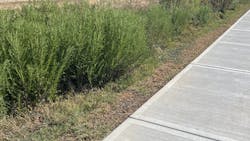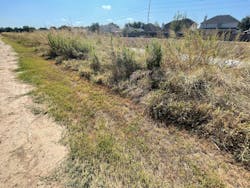The evolution of stormwater management practices has manifested as a pursuit of solutions to those practices’ unintended consequences such as downstream flooding, significant soil erosion caused by increased water velocities, and greater volumes as well as elevated concentrations of pollutants transported into natural waters by stormwater runoff. In response, U.S. Environmental Protection Agency (EPA) and others’ studies lead to updated regulations and guidelines at the federal level, which state and local municipalities can then adopt within their own codes and design criteria.
The concept of low impact development (LID) and green infrastructure (LID/GI) emerged nearly 30 years ago as the next best practice in storm water management.
According to EPA, LID/GI is to, on its own or integrated with existing traditional gray infrastructure, “... reduce runoff and to mimic a site’s predevelopment hydrology by minimizing disturbed areas and impervious cover and then infiltrating, filtering, storing, evaporating, and detaining storm- water runoff close to its source.”1 Like its predecessor stormwater management practices, however, LID/GI is not always evaluated for its effectiveness or is regularly or properly inspected, maintained and/or permitted as required.The efficacy of LID/GI can seem obvious. The implementation of a mixture of its techniques appropriate to the project — such as bioswales, green roofs, pervious concrete, tree pits and the like — can provide natural filtration of pollutants, reduce runoff flow volume and improve runoff quality.
However, in one of its reports about overcoming barriers to green infrastructure, EPA speaks to the perception that LID/GI’s performance is unknown, slowing the adoption of the practice.
“Local governments are in the best position to promote sustainable stormwater management on a larger scale. They also face some of the most complex challenges. Resources are limited, responsibilities are fragmented, and the tolerance for risk is generally low.”2
Despite much scientific data supporting the effectiveness of LID/GI available today, additional barriers and challenges impeding the widespread adoption of LID/GI by local governments include the failure of estimating costs, planning and budgeting for maintenance, and the lack of community engagement in implementation decisions.
A Demonstration Project to Prove Efficacy
One solution EPA suggests, and that a Texas county is currently pursuing, is to capture data that proves performance by carrying out a demonstration project. Set up at the direction of a county flood control district, the demonstration project looks to evaluate performance of a storm water management LID feature designed to address pollutant discharges as well as reduce runoff volume from residential development areas.
Though the district already has stormwater quality best management practices (BMPs) in place, these are not always subject to methodical per- formance testing. The purpose of this Texas county LID/ GI demonstration project is to evaluate the effectiveness and practicality of modifying a currently maintained backslope drain- age system by integrating LID practices to improve the quality of storm water runoff while reducing the total volume of runoff. Organized in accordance with the project’s quality assurance project plan, the green infrastructure bioswale project details elementsincluding:
- Site selection criteria
Sample design of what is to be collected - Location of monitoring sites, for control and for the design section
- Monitoring schedule Stormwater quality system design of a retrofitted vegetated swale
- The methods and techniques for rainfall and runoff measurements of intensities and volumes
- Requirements for volume and level monitoring to assess hydraulic performance and volume reduction
- The methods in which infiltration rates will be monitored and recorded
- Water quality objectives and criteria to evaluate this Integrated Management Practice
- Qualifying storm event requirements for sample collection
- Monitoring and sampling equipment
- Mobilizing criteria prior to field sample collection
- Sample collection and general field procedures
For the current Phase 1 of this project, the control site is a traditional grass-lined swale located approximately 100 yards from the design site. The design site itself is on a backslope swale which includes retrofitted plantings with native vegetation. The retrofitted plantings selected for the design site are dense at the plant- ing base and have longer root systems.
These adaptations allow the plants to remain in place during a large storm event while increasing water infiltration into the ground, reducing runoff and increasing filtration. What appears to be obvious by just an observation — that flow is reduced, so there should be a commensurate reduction in the pollutant load — is just theory until validated by data. Once the demonstration project is completed, analysis of the data will show if the hypothesis is proven.
Knowing and KeepingUp with Maintenance, Monitoring and Permitting
Barriers to LID/GI do not end with ques- tions about its performance. There are questions as to whether this intervention comes at a higher cost or with greater maintenance requirements. An EPA study found that in most cases significant savings were realized due to reduced costs for site grading and preparation, stormwater infrastructure, site paving, and landscaping. Total capital cost savings ranged from 15 to 80% when low impact development methods were used.3
In maintenance, communities and developers should look beyond the initial capital costs of gray infrastructure installation to its necessary ongoing maintenance, often requiring the use of heavy equipment for work such as pond dredging, debris and sediment removal. LID/GI can involve a lower initial cost than that of gray infrastructure though with more ongoing maintenance in the early years as plantings get established. Subsequent maintenance can be like that required of any landscaping – mowing, weeding and debris removal.
- For the property owner to whom the private developer transfers a property, there are the challenges in maintaining the post-construction maintenance and permitting required due to the loss of institutional knowledge as people transition — either in the regulating public agencies or within the private organization where personnel may be unaware that the LID/GI facility is a required part of the development’s storm water man- agement system. Not all local jurisdictions require post- construction stormwater quality feature permitting and, often, this results in the property owner not being aware that the system with the water quality feature requires an annual permit renewal. A best practice to assure both the required maintenance and permit status on the LID/GI facility continue during the post-construction phase of the development includes:
- Get buy-in from the developer/owner, at the time of new development or significant redevelopment, on the requirements of a LID/GI facility’s performance and ongoing maintenance and assign its oversight to a position within the organization rather than an individual.
- Incorporate the LID/GI facility’s upkeep into the property’s overall main tenance plan.
- Create and maintain a database of performance test results, inspections, maintenance work and permits.
- Set up a reminder tool to complete requirements to secure and pay for annual permit renewals.
- Develop a relationship with the governing municipality and stay on top of its changes in personnel.
The reported benefits of LID/GI unrelated to environmental goals are legion, as it allows more flexibility in urban site design, it can reduce or eliminate the need for larger detention ponds and traditional flood control BMPs, and it enhances a development’s aesthetics. Given these advantages and
those said to achieve higher environmental performance, it can be a business imperative to institute LID/GI practices, performance testing, maintenance and permitting requirements as appropriate, depending on whether you are the developer, a local government, or the property owner as the end user.
References
1. Managing Stormwater with Low Impact Development Practices: Addressing Barriers to LID https://www3.epa.gov/region1/ npdes/stormwater/assets/pdfs/ AddressingBarrier2LID.pdf
2. Overcoming Barriers to Green Infrastructure
https://www.epa.gov/green-infrastructure/
overcoming-barriers-green-infrastructure
3. Reducing Stormwater Costs through
Low Impact Development (LID) Strategies and Practices https://www.epa.gov/sites/default/ files/2015-10/documents/2008_01_02_ nps_lid_costs07uments_ reducingstormwatercosts-2.pdf
About the Author
Ralph Calvino
Ralph Calvino REM, CPESC, CESSWI, is a Senior Associate serving as Terracon’s Regional Manager of Environmental Services for Southeast Texas, while supporting the Regulatory Compliance practice across the State of Texas and beyond. His 30 years of experience includes over a decade in state government and 22 years in various consultant roles including Project Director and Stormwater Technical Practice-Group Leader at a Fortune 500 Global Firm.



